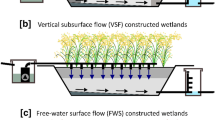Abstract
In spite of the low temperature during the winter season and the high land environment, the wetland treatment system is gaining popularity in Korea because of its lower construction cost and simplicity in operation and maintenance. Many different types of wetland treatment systems have been built during the last 10 years, among which the free water surface wetland has been predominant. Most of the large-scale systems are government projects for improving the water quality of the streams flowing into the estuary dikes and reservoirs. The covering plants used in this system are different in different areas but cattails and reeds or their combinations are common. Constructed wetlands in Korea can be characterized by their shallow depths and short hydraulic residence times. There is no established flow pattern and configuration rules for constructing wetlands, but many efforts have been made with a view to improving their ecological function. Flow control is the most difficult problem in designing a riverbed or riparian wetland. There have been scores of flow rate control devices developed for wetlands, but none of them guarantee wetlands’ safety against flooding. In earlier wetland construction, the building materials were mainly soil. Recently, strong and durable building materials such as rocks, gravel beds, concrete and steel are used at vulnerable places to protect them from erosion. Our investigation indicated that the wetland system would be an appropriate technology because it is not only cheaper to construct, but also requires less maintenance work. However, we suffer from the reduced effectiveness in performance during the winter. We need to evaluate the partial treatment accomplished during 6 to 7 months per year.
Similar content being viewed by others
References
Crities, R., and G. Tchobanoglous, 1998. Small and Decentralized Wastewater Management Systems. McGraw-Hill, New York, 527–610.
Korean Ministry of Agriculture/KARICO, 2005. Guidelines of Wetland Construction and Operation. Anyang, Korea, 56 pp.
Kim, Y., 2005. Prospects of constructed wetland treatment in Korea. In: Korean Waterworks Towards Globalization. Hallimwon Publication Co., Seoul, 151–168.
Reed, S. C, E. J. Middlebrooks, and R. W. Crites, 1998. Natural Systems for Waste Management and Treatment. McGraw-Hill, New York, 13–15.
EPA, 1988. Design Manual for Constructed Wetlands and Aquatic Plant Systems for Municipal Wastewater Treatment, U. S. EPA, Center for Environmental Research Information, Cincinati, OH, 21–40.
Author information
Authors and Affiliations
Corresponding author
Rights and permissions
About this article
Cite this article
Youngchul, K., Gilson, H., Jin-Woo, L. et al. Experiences with constructed wetland systems in Korea. J Ocean Univ. China 5, 345–350 (2006). https://doi.org/10.1007/s11802-006-0027-9
Received:
Accepted:
Issue Date:
DOI: https://doi.org/10.1007/s11802-006-0027-9




